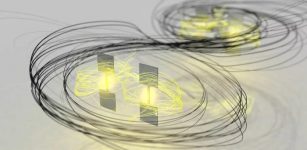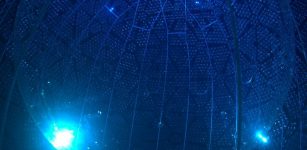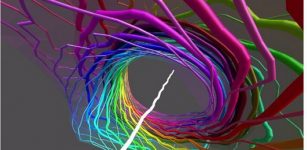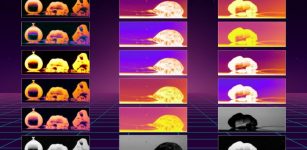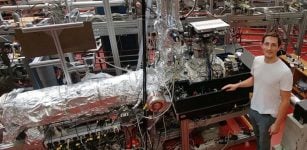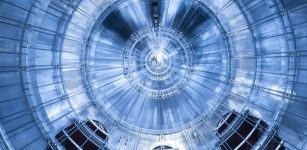Tempest In A Teacup: Physicists Make Breakthrough In Creating Turbulence
Eddie Gonzales Jr. – MessageToEagle.com – Turbulence is all around us. It’s in the swirl of coffee and milk in a latte, unfurling along the wings of airplanes and the sides of cars, churning the blood in your heart after the valve snaps closed. Yet we still don’t fully grasp all of its rules.
University of Chicago scientists pioneered a way to create a contained “ball” of turbulence in a tank of water, which has never been done before. Above, a visualization shows the average energy density of the ball over time. Credit: Takumi Matsuzawa
Part of the challenge is that physicists typically start by isolating the phenomenon from its environment to study it—but stirring a cup means the spoon is always still inside it, affecting the movement of the liquid. There hasn’t been a way to separate the turbulence out by itself.
A group of University of Chicago scientists, however, have pioneered a way to create contained turbulence in a tank of water. They use a ring of jets to blow loops until an isolated “ball” of turbulence forms and lingers.
“It was a surprise to us,” said physicist Takumi Matsuzawa, the first author on a study describing the findings, published in Nature Physics. “It’d be like calmly sitting in a field with a picnic and watching a storm raging 50 feet away,” said Prof. William Irvine, the corresponding author on the study.”
They hope the breakthrough opens a new avenue of study to better understand turbulence.
‘No one knew this was even possible’
Turbulence—the chaotic flow in an unevenly mixed substance—is an old problem. “It’s often quoted as one of the big open questions in physics,” said Irvine.
In the past decades, scientists have made progress in describing the behavior of an “idealized” state of turbulence. That is, turbulence without confounding variables like boundaries, or variations in strength and time. But when it comes to understanding real-world turbulence, there is much left to understand.
“Turbulence appears everywhere around us, but it keeps eluding what physicists consider a satisfying description,” said Irvine. “For example, if you ask, can I predict what happens next when I poke this region of turbulence? The answer is no. Not even really with a supercomputer.”
One of the big problems was the presence of confounding variables in experiments. You can make turbulence by shooting a fast jet of water through a pipe or by stirring a paddle in a tank of water, but the turbulence is always brushing up against the container walls and the stirrer, which affects the results.
Matsuzawa, Irvine, and their collaborators had been running experiments with tanks of water to make “vortex rings”—like smoke rings, but in water. When they tried to combine them to make turbulence, the energy usually bounced right back at them before dissipating.
But once they hit upon a particular configuration—a box with eight corners, each containing a vortex ring generator—something odd happened.
When they repeatedly fired rings that met in the center, they saw a ball of turbulence form that was self-contained, away from the walls of the tank.
This itself was a breakthrough: “No one knew this was even possible,” said Matsuzawa, who is a graduate student in physics. “Turbulence is very good at mixing things; if you mix your milk into your coffee, you can only get one or two swirls in before it becomes completely mixed. The fact we can contain it in place is very surprising.”
Matsuzawa explained that a freestanding ball of turbulence allows scientists, using lasers and multiple fast cameras, to track its parameters much more precisely. This includes its energy and its helicity (a measure of how tangled or “knotty” the loops are) as well as the impulse and angular impulse (the fluid equivalent of momentum and angular momentum).
What’s more, they could play with it by varying the parameters. They could change whether the loops they sent in were helices spinning clockwise or counterclockwise. They could change the amount of energy going in, or stop adding rings and watch the turbulence dissipate, or vary the helicity of the rings and see how the turbulence evolved over time.
“How does turbulence dissipate? How does it expand? What does it ‘remember’? How does the energy spread across scales? Are there different types of turbulence? There are all kinds of questions we could ask, and this is a unique setting with which to ask them,” Irvine said. “I really hope this can help open up a new playground in the field.”
Written by Eddie Gonzales Jr. – MessageToEagle.com Staff


